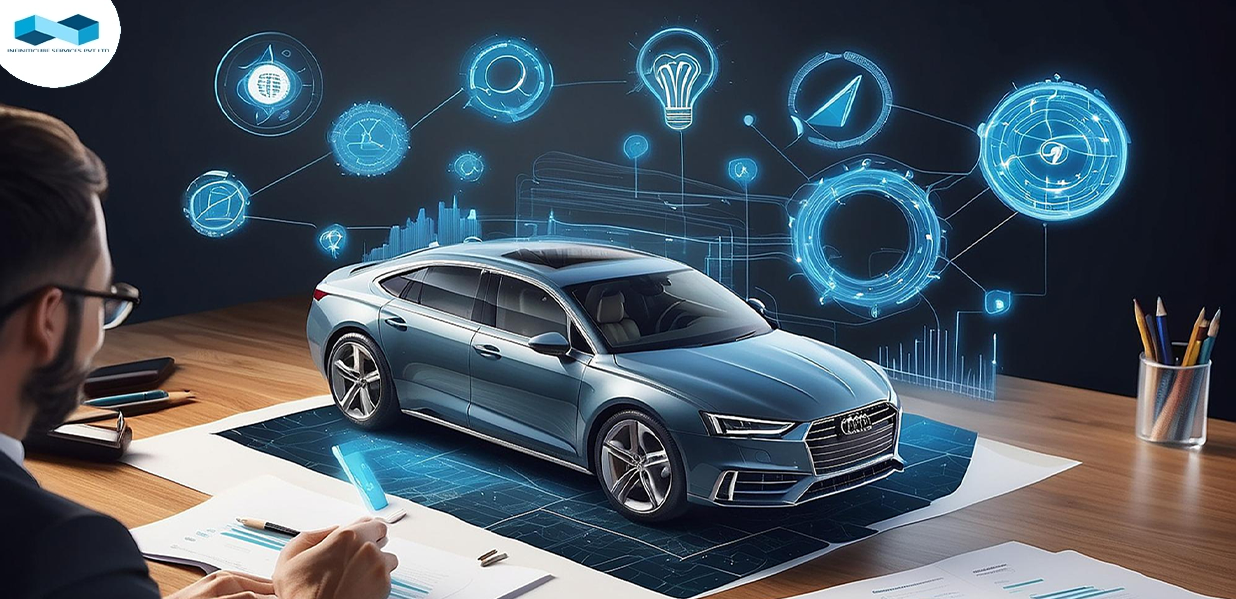How Smart Sensors Driving Automotive Industry Towards Growth
Today, technology seamlessly integrates into every aspect of our lives, and the automotive industry is no different. This industry stands out as a beacon of innovative transformation, propelled forward by the advent and integration of smart sensors. These miniature yet powerful sensors are transforming how vehicles are designed, manufactured, and operated, driving the automotive industry toward unprecedented growth and efficiency.
The worldwide market for automotive sensors is expected to expand from a value of USD 30.8 billion in 2023 to reach USD 62.2 billion by 2028, experiencing a compound annual growth rate (CAGR) of 15.0% during the period from 2023 to 2028.
[Source]
As we proceed further in this blog, we will understand the pivotal role that smart sensors play in shaping the future of mobility. This blog post aims to explore the dynamic ways in which smart sensors are fueling the automotive industry's toward innovation, sustainability, and unparalleled customer experience.
Applications and Benefits of Smart Sensors in the Automotive Industry
Smart sensors, equipped with the capability to collect, analyze, and transmit information, are tremendously changing the automotive industry and user experience. Let's delve into the key applications and benefits of smart sensors in vehicles:
Advanced Driver-Assistance Systems (ADAS)
- Definition: ADAS are systems that aid the driver in the driving process through automation and improved safety.
- Sensor Use: Cameras, radars, LiDAR (Light Detection and Ranging), and ultrasonic sensors are used to enable features like automatic emergency braking, lane departure warning, and adaptive cruise control.
- Benefits:
- Safety: Reduced accidents and fatalities by alerting drivers to potential dangers and assisting in emergencies.
- Convenience: Making driving easier and less stressful by handling certain tasks, such as maintaining a safe following distance.
- Efficiency: Optimizing speed and braking to improve fuel economy and reduce wear on the vehicle’s components.
Autonomous Driving
- Definition: Autonomous vehicles are capable of driving themselves without human intervention, using a combination of sensors, cameras, and AI.
- Sensor Use: Multiple sensors like cameras, radars, LiDAR, and ultrasonic sensors create a detailed picture of the vehicle’s surroundings.
- Benefits:
- Safety: The potential to eliminate human error, which is a significant cause of accidents, making roads safer for all users.
- Accessibility: Providing mobility to those unable to drive due to age, disability, or other factors.
- Efficiency: Optimizing traffic flow, reducing congestion, and improving fuel efficiency by enabling vehicles to communicate with each other.
Vehicle-to-Everything (V2X) Communication
- Definition: V2X communication enables vehicles to share data with each other and with the surrounding infrastructure.
- Sensor Use: Dedicated short-range communication (DSRC) or cellular networks allow vehicles to exchange information such as speed, location, and road conditions.
- Benefits:
- Safety: Alerts drivers to potential hazards beyond their line of sight, such as a vehicle running a red light or icy road conditions.
- Traffic Management: Optimizing traffic flow by coordinating vehicle speeds and routes, reducing congestion and emissions.
- Emergency Response: Facilitating quicker emergency response by providing real-time data on accidents or road closures.
Fuel Efficiency and Emissions Reduction
- Sensor Use: Sensors monitor the vehicle’s performance, environmental conditions, and driver behavior to optimize fuel consumption.
- Benefits:
- Cost Savings: Lower fuel costs for vehicle owners and reduced environmental impact from burning less fuel.
- Compliance: Helping manufacturers meet increasingly stringent emissions standards by fine-tuning engine and vehicle operation.
- Sustainability: Contributing to a cleaner environment by reducing greenhouse gas emissions and air pollutants.
Predictive Maintenance
- Definition: Predictive maintenance uses sensors to monitor the condition of vehicle components and predict when maintenance or repairs are needed.
- Sensor Use: Sensors measure factors like temperature, vibration, and fluid levels to detect early signs of wear or malfunction.
- Benefits:
- Reduced Downtime: Minimizing unexpected breakdowns by addressing issues before they cause a failure.
- Cost Savings: Lower maintenance costs through more efficient scheduling and the ability to replace parts before they fail catastrophically.
- Extended Lifespan: Prolonging the life of vehicle components by ensuring they are properly maintained and repaired.
Also Read: How Smart Sensors Are Driving Smart Cities Towards Growth
Technological Advancements Driving the Adoption of Smart Sensors
Smart sensors are becoming increasingly integral to the automotive industry, thanks to significant technological advancements that enhance their functionality, reliability, and integration capabilities. Here's how these developments are shaping the future of smart sensors in vehicles:
Miniaturization and Power Efficiency
- Smaller Size, Bigger Impact: Advances in technology have significantly reduced the size of sensors, allowing them to be integrated into vehicles without compromising space or design.
- Enhanced Power Efficiency: Modern sensors consume less power, extending the life of the vehicle's battery and reducing the need for frequent maintenance.
Multi-Sensor Integration and Sensor Fusion
- Comprehensive Data Collection: Vehicles now integrate multiple types of sensors, such as radar, lidar, and cameras, to collect a wide range of data about their surroundings.
- Unified Processing: Sensor fusion combines data from various sources to create a more accurate and comprehensive understanding of the vehicle's environment, improving decision-making processes.
Artificial Intelligence (AI) and Machine Learning
- Smart Decision-Making: AI and machine learning enable sensors to interpret data more effectively, allowing vehicles to make smarter decisions based on real-time information.
- Adaptive Learning: These technologies allow sensors to learn from past data, enhancing their predictive capabilities for maintenance, traffic patterns, and safety hazards.
Edge Computing Capabilities
- Faster Processing: By processing data locally on the vehicle (at the edge), sensors can significantly reduce response times, crucial for safety-critical applications like autonomous driving.
- Reduced Bandwidth Needs: Edge computing minimizes the amount of data that needs to be sent to the cloud, easing network congestion and lowering transmission costs.
Enhanced Connectivity (5G, Wi-Fi, Bluetooth)
- Real-Time Communication: The advent of 5G and improvements in Wi-Fi and Bluetooth technologies enable sensors to communicate in real-time, essential for vehicle-to-vehicle (V2V) and vehicle-to-infrastructure (V2I) interactions.
- Seamless Integration: Enhanced connectivity ensures that vehicles can easily integrate with smart city infrastructure, improving navigation, safety, and efficiency.
Reliability and Durability Improvements
- Tougher Sensors: Technological advancements have made sensors more durable and reliable, capable of withstanding harsh environmental conditions without degradation in performance.
- Consistent Performance: Improvements in sensor technology ensure that they operate consistently over a longer lifespan, reducing the need for replacements and maintenance.
Energy Harvesting and Sustainable Operation
- Self-Powered Sensors: Innovations in energy harvesting enable sensors to generate power from their surroundings (e.g., vibrations, thermal differences), making them self-sufficient and sustainable.
- Eco-Friendly Solutions: These advancements contribute to reducing the overall energy consumption of vehicles, aligning with global sustainability goals.
Also Read: How Smart Sensors Driving Industry 4.0 Towards Growth
Future Outlook and Opportunities for Innovation
The automotive industry stands on the brink of a technological revolution, with smart sensors playing a central role. The future outlook reveals a landscape ripe with opportunities for innovation, characterized by the emergence of new sensor technologies, integration with other cutting-edge technologies, expansion into new markets, and several challenges that stakeholders must navigate.
Emerging Sensor Technologies
- Nanotechnology in Sensors: The development of nanosensors could significantly enhance detection capabilities, making vehicles even more responsive to environmental changes.
- Flexible and Wearable Sensors: The integration of flexible sensors into vehicles can offer new ways to monitor structural health or adjust interiors based on occupants' needs.
- Advanced Imaging Sensors: Improvements in imaging sensors, including infrared and thermal, promise to improve night vision and bad weather navigation.
Integration with Emerging Technologies
- Artificial Intelligence (AI) and Machine Learning (ML): These technologies enable smarter data processing from sensors, leading to improved decision-making for autonomous and semi-autonomous vehicles.
- Internet of Things (IoT): Connecting vehicles to the IoT ecosystem can enhance vehicle-to-everything (V2X) communication, improving traffic management and safety.
- 5G Connectivity: Faster data transmission speeds will enhance the efficiency and reliability of communication between smart sensors and vehicle systems, as well as external networks.
Market Expansion Beyond Passenger Vehicles
- Commercial and Industrial Applications: Smart sensors are expanding into commercial vehicles, contributing to safer and more efficient logistics and transportation.
- Public Transportation: Integrating smart sensors in buses and trains can enhance safety, maintenance, and operational efficiency, improving the public transportation system.
- Agriculture and Construction: Vehicles in these sectors benefit from smart sensors through improved navigation, operational efficiency, and safety in challenging environments.
Challenges and Considerations for Industry Stakeholders
- Privacy and Security: With increased data collection, ensuring the privacy and security of user information becomes paramount.
- Standardization and Compatibility: Developing industry-wide standards for sensors and data communication to ensure compatibility and interoperability across different brands and models.
- Cost and Accessibility: Balancing the cost of advanced sensor technologies to keep vehicles affordable while investing in innovation.
- Regulatory Compliance: Adapting to changing regulations that govern vehicle safety, emissions, and technology use without stifling innovation.
Conclusion
Emerging sensor technologies and their integration with cutting-edge advancements like artificial intelligence, the Internet of Things, and 5G connectivity are paving the way for smarter, more connected, and autonomous vehicles. Beyond passenger vehicles, the applications of smart sensors are expanding into commercial, industrial, and public transportation sectors, indicating a broader market expansion and the potential for significant impact on global transportation systems.
However, this journey is not without its challenges. Industry stakeholders are tasked with navigating issues of privacy, security, standardization, cost, and regulatory compliance to fully harness the potential of smart sensors. The path forward requires a collaborative effort among manufacturers, technology providers, policymakers, and consumers to address these challenges and realize the vision of a safer, more efficient, and sustainable automotive future.
Whether you're looking to enhance vehicle safety, improve efficiency, or pioneer the next breakthrough in autonomous driving, our Data Analytics Solutions can empower your business to achieve its goals.
By partnering with us, you'll gain access to expert insights that transform raw sensor data into actionable intelligence, driving innovation and growth. Our tailored analytics strategies are designed to meet your unique needs, ensuring that you can navigate the complexities of the automotive landscape with confidence.
Contact us today to discover how our Data Analytics Solutions can accelerate your journey toward becoming a leader in the automotive industry. You can also schedule a call with our expert to discuss your requirements.
 June 27, 2025
June 27, 2025
 Balbir Kumar Singh
Balbir Kumar Singh
 0
0
 June 13, 2025
June 13, 2025
 Balbir Kumar Singh
Balbir Kumar Singh
 0
0









Leave a Reply